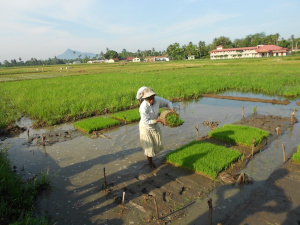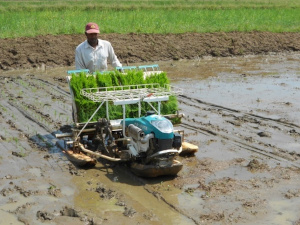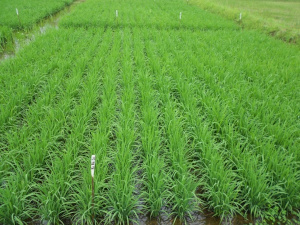
- Address : Bathalagoda, Ibbagamuwa, Sri Lanka
- E- Mail : rrdi@doa.gov.lk
- Telephone : +94 372 258561
- Fax : +94 372 259881
TECHNOLOGIES
Agronomy Division - Mechanical transplanting of rice
Mechanical transplanting using walk behind type automated mechanical transplanter involves the transplanting of young seedlings grown in a mat nursery. It minimizes weed problem and huge labour usage in rice cultivation while ensuring a uniform plant population due to uniform planting space and depth with timeliness crop establishment (Singh and Rao, 2010).
To transplant 1 acre of paddy land, about 30 m2 nursery is required. Field collected decomposed soil (should be free from plant debris or stones) or a mixture of sieved soil and compost (4:1) can be used. A raised nursery bed with 60 cm wide, 2.5-5 cm height to a convenient length is prepared and left to settle for 36-48 hours before seeding. If the nursery is established on a polythene sheet, the polythene should be evenly perforated with tiny holes to improve drainage. A thin soil layer (1.5-2.5 cm) collected from either side of the bed should be evenly spread and levelled over the polythene. If nursery trays are used (30 cm wide, 60 cm length), they should be placed on the bed as two rows and the soil is filled up to the edge uniformly. To transplant one acre, 100 seedling trays are required.
The seeds should be pre-germinated (soaked in water for 24 hours and incubated for 24 hours) before sowing in the nursery. A seed treatment (Imidacloprid 70% WS or Thiamethoxam 70 % WS) to overcome thrips attach during the nursery period is needed. The pre-germinated seeds should be uniformly spread over the nursery bed/ seedling trays. The nursery should be covered with banana leaves, coconut leaves or by using polythene to avoid direct exposure to sunlight or heavy rain. After 3-4 days, once the seedlings are emerged the cover materials can be removed. During the first 3-4 days, the nursery bed should be moisten at least twice a day using a water can to avoid any water stress. Then it can be irrigated using flooding furrows prepared between the beds. The irrigation water should be drained out12-18 h prior to transplanting. If the nursery is raised on a polythene sheet, mat should be cut using a sharp knife to the size fitted to the transplanter.
Long or medium age rice varieties with high tillering ability and having extended vegetative growth are more suitable for mechanical transplanting (eg. Bg 403, Bg 379-2, Bg 406, Bg 450, Bg 357, Bg 366, Bg 360, Bw 367, At 362, Bw 372, Co-10). Seed paddy requirement to transplant one acre is about10-15 kg of certified seeds (20 kg per acre (Kg ac-1) maximum to avoid risk). For samba varieties, 10-12 Kg ac-1 are adequate. Optimum seeding rate for nursery is 500 g m-2 . If seedling trays are used, 100 trays ac-1 and 100-150 g of seed paddy tray-1 can be used. Seedlings of 8-16 days can be used for transplanting (15-20 cm tall), but 12 days old seedlings are the optimum. Suitable within row spacing are 14, 16 and 18 cm for 4-4 ½ months and 12, 14 and 16 cm for 3 ½ months age rice varieties. Planting 4-6 seedlings per hill (hill -1) with a planting depth of 1.5-2.5 cm (medium) is optimum.
The field should be ploughed twice, puddled and levelled and allowed to settle for 24-48 hours. A shallow layer of of standing water (1-2 cm) can be maintained in the field while transplanting. Before transplanting, an area equivalent to one pass of the machine on all four sides of the field should be kept to avoid damage to already transplanted seedlings while turning the machine. The transplanting should be done parallel to the bund of the field and every return pass should be also parallel to the previous row to maintain even row distance. The four corners of the field and missing hills should be transplanted manually.
Weed management in mechanically transplanted rice can be done using i. application of a pre-emergent herbicide+3-5 cm standing water after 3 days, ii. pre-emergent herbicide+power weeder, iii.1-2 cm of standing water for 3-4 days and then 3- 5 cm standing water+ post emergent herbicide iv. post emergent herbicide+power weeder (before 10 days of establishment and then where necessary ), iv. a combination of herbicide + water management + power weeder or, v. power weeder+hand weeding. Fertilizer application, pest & disease control and other agronomic management practices are done as recommended by the DOA. Large and square/rectangular shape plots can increase the machine efficiency.
Mechanical transplanting is highly effective for large plots than small plots since. Turning and moving of the machine is also difficult in narrow and undulated rice fields especially in hilly areas. Also, the machine cannot be used in bog or half bog soils. The crop transplanted by the mechanical transplanter delays for 7-10 days to mature compared with direct seeding.




